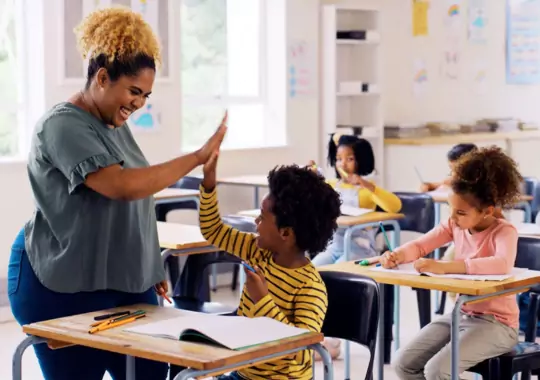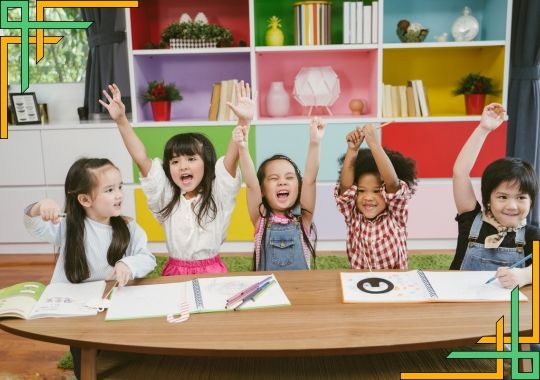As parents, we all aspire to inspire learning in our children and see them succeed in every aspect of life, including academics. However, unintentional pressure can sometimes lead to an aversion to studying. Here, we delve into the ten best ways to motivate your child to study without causing a protest.
As Amazon affiliates we may earn a commission if you purchase a product at no cost to you.
Sit with Your Child
Sitting with your child during study sessions is not just about physical presence; it's about actively engaging with them to inspire learning. By being by their side, you create a supportive atmosphere where they feel encouraged and motivated to delve into their studies.
This closeness fosters a sense of security and confidence, allowing your child to ask questions and seek clarification without hesitation. Moreover, your presence demonstrates that you value their education and are committed to helping them succeed.
Emphasize Learning Over Grades
Shifting the focus from grades to the joy of learning is essential for inspiring a lifelong love of education in children. Encouraging them to discuss what they learned in class fosters a deeper understanding of the subject matter and promotes critical thinking skills.
By prioritizing the process of learning over the outcome of grades, children are more likely to engage actively in their studies and develop a genuine curiosity for knowledge.
Be Supportive
Being supportive and understanding, rather than pressuring children to perform well, is crucial for inspiring learning. By seeing things from their perspective, parents can create a nurturing environment where children feel safe to explore, make mistakes, and grow. This approach fosters a positive attitude towards learning and encourages children to pursue their interests with enthusiasm.

Discuss Studies
Engaging in conversations about your child's daily school activities fosters a deeper connection and understanding of their educational journey. By discussing their studies, parents can keep children engaged, informed, and motivated to learn. This approach encourages open communication, allows parents to address any challenges or concerns, and celebrates achievements together.
Establish a Study Schedule
Establishing a study schedule involves more than just setting aside time for studying; it requires creating a well-organized plan tailored to individual needs and goals. Here are additional insights to consider:
Identify Priorities: Determine which subjects or tasks require more attention and allocate study time accordingly. Prioritizing tasks helps in managing time effectively.
Set Realistic Goals: Break down larger tasks into smaller, manageable goals. Setting achievable milestones provides a sense of accomplishment and motivation to continue studying.
Create a Flexible Schedule: While consistency is crucial, it's also important to be adaptable. Life can be unpredictable, so having a flexible study schedule allows for adjustments without disrupting the overall routine.
Include Breaks: Integrate short breaks into the study schedule to avoid burnout and maintain focus. Breaks are essential for rejuvenating the mind and enhancing productivity.
Utilize Effective Study Techniques: Experiment with different study methods to find what works best. Techniques like active recall, spaced repetition, and summarization can enhance learning and retention.
Regularly Review and Adjust: Periodically review your study schedule to assess its effectiveness. Be open to making adjustments based on your progress, changing priorities, or any unforeseen circumstances.
By incorporating these strategies into the establishment of a study schedule, individuals can optimize their learning potential and achieve academic success. Consistency, adaptability, and a proactive approach are key elements in developing and maintaining effective study habits.
Create a Distraction-Free Environment
Ensuring that the study area is free from distractions is essential for fostering an environment conducive to learning and maintaining focus. Distractions can disrupt a child's concentration, leading to decreased productivity and retention of information. By creating a space where distractions are minimized or eliminated, children can better engage with their studies and absorb the material effectively.
One way to achieve a distraction-free environment is to designate a specific study area that is quiet and free from noise. This area should be away from high-traffic areas of the home and equipped with all the necessary study materials, such as books, notebooks, and stationery. Removing electronic devices or limiting their use during study sessions can also help reduce distractions and promote focused learning.
Additionally, establishing a routine for study sessions can contribute to a distraction-free environment. Having a set schedule for studying encourages consistency and discipline, reducing the likelihood of interruptions or procrastination. Encourage your child to adhere to this schedule, emphasizing the importance of dedicated study time and the benefits of maintaining focus.
Furthermore, parents and caregivers play a crucial role in creating a distraction-free environment by providing support and guidance to their children. By actively participating in their child's learning journey and offering encouragement, parents can motivate their children to stay focused and committed to their studies. Open communication and understanding between parents and children can also help address any challenges or distractions that may arise during study sessions, fostering a positive and conducive learning environment.
Collaborate with Teachers
If your child encounters challenges in a specific subject, collaborating with their teacher can be highly beneficial. By working together, you can develop tailored strategies to ignite your child's interest and enhance their academic performance. Teachers possess valuable insights into your child's learning style, strengths, and areas needing improvement. By leveraging this knowledge through collaboration, you can create targeted interventions to address your child's difficulties effectively.
Engaging in open communication with your child's teacher fosters a supportive learning environment. Through discussions about your child's progress and challenges, you can gain valuable perspectives and access resources to support their academic journey. Additionally, collaborative efforts between parents and teachers demonstrate a shared commitment to your child's success, reinforcing a sense of teamwork and dedication to their education.
Collaborating with teachers also allows for the implementation of diverse teaching strategies tailored to your child's needs. Teachers can provide recommendations for supplementary materials, tutoring options, or alternative learning approaches to complement classroom instruction. This collaborative approach empowers both parents and teachers to explore innovative methods that resonate with your child, fostering engagement and fostering a deeper understanding of the subject matter.
Furthermore, collaborating with teachers emphasizes the importance of holistic support for your child's academic journey. By working together to address academic challenges, you demonstrate to your child the value of seeking assistance and embracing continuous improvement. This collaborative effort not only enhances your child's academic performance but also cultivates vital skills such as communication, problem-solving, and resilience.
Cater to Your Child's Learning Style
Understanding your child's learning style is crucial for effective education. By identifying whether your child is an auditory, visual, or kinesthetic learner, you can tailor study methods to suit their individual needs.
Auditory Learners: If your child is an auditory learner, they may benefit from listening to recorded lectures, engaging in discussions, or using mnemonic devices to remember information. Encourage them to read aloud or explain concepts verbally to reinforce their understanding.
Visual Learners: Visual learners comprehend information best through visual aids such as diagrams, charts, and videos. Provide colorful materials, utilize educational videos, and encourage them to draw or create visual representations of concepts.
Kinesthetic Learners: Kinesthetic learners thrive through hands-on activities and movement. Incorporate interactive exercises, experiments, and role-playing into their learning experience. Allow them to manipulate objects or participate in physical activities to reinforce learning.
Adapting study methods to align with your child's learning style enhances engagement, retention, and overall academic success. It's essential to observe your child's preferences and adjust strategies accordingly to create a supportive and effective learning environment.

Set Study Goals Together
Collaborating with your child to establish study goals fosters a sense of ownership and accountability in their academic journey. Here's how:
Short-term Goals: Start with short-term objectives that are achievable within a few days or weeks. These goals provide immediate targets for your child to work towards and experience the satisfaction of accomplishment.
Medium-term Goals: Medium-term goals extend beyond short-term objectives but are attainable within a few months. They offer a balance between immediate progress and longer-term aspirations, helping your child maintain momentum and focus.
Long-term Goals: Long-term goals encompass broader academic achievements that may take a semester, year, or more to accomplish. These goals provide direction and purpose, guiding your child's academic efforts over an extended period.
Setting study goals together enables your child to develop essential skills such as time management, organization, and perseverance. Regularly revisiting and adjusting these goals ensures they remain relevant and aligned with your child's evolving needs and aspirations.
Respect Your Child's Opinion
Valuing your child's opinions cultivates a supportive and nurturing environment that encourages open communication and mutual respect. Here's how to accomplish this:
Active Listening: Practice active listening when your child shares their thoughts and ideas. Give them your full attention, maintain eye contact, and refrain from interrupting. Acknowledge their perspective to demonstrate that their opinions are valued and heard.
Encouragement: Encourage your child to express their opinions freely, without fear of judgment or criticism. Praise their efforts in communicating their thoughts, even if you may not always agree with them. This fosters their confidence and self-esteem, empowering them to voice their opinions confidently.
Validation: Validate your child's feelings and opinions, even if they differ from your own. Let them know that it's okay to have different viewpoints and that their thoughts are valid and respected. Avoid dismissing or belittling their opinions, as this can undermine their self-confidence.
By respecting your child's opinions, you foster a sense of autonomy and independence, which are essential for their emotional and cognitive development. Creating an environment where their opinions are valued sets the foundation for healthy communication and strengthens your parent-child bond.
Recommended Article

Frequently Asked Questions FAQs
What are some effective ways to inspire learning in children at home?
There are several strategies to foster a love for learning in children within the home environment. Encourage reading by providing a variety of age-appropriate books, engage in educational games and activities, create a dedicated learning space, and involve children in everyday tasks that promote problem-solving skills.
How can parents incorporate technology to inspire learning in their children?
Integrating technology thoughtfully can be a powerful tool for education. Parents can explore educational apps, online resources, and interactive platforms that align with their child's interests and developmental stage. Supervised screen time, combined with hands-on activities, can enhance learning experiences and make education enjoyable.
What role do positive reinforcement and encouragement play in inspiring learning in children?
Positive reinforcement and encouragement are vital in building a child's confidence and motivation to learn. Celebrate small achievements, provide praise for effort, and create a supportive environment where mistakes are viewed as opportunities to learn. Recognizing and reinforcing a child's curiosity and achievements can have a lasting impact on their attitude towards learning.
Conclusion
It's essential to foster an environment that nurtures curiosity and a love for learning in children. By incorporating strategies that inspire learning, such as promoting inclusion, embracing diverse learning styles, and encouraging hands-on experiences, we can cultivate a lifelong passion for knowledge. Our goal is to inspire learning in children by creating supportive and inclusive environments.










